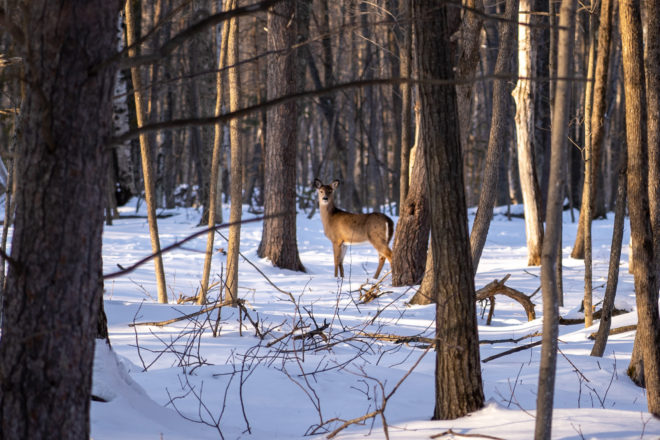Balancing the Deer with the Forest
- Share
- Tweet
- Pin
- Share

Foresters Want Fewer Deer So Understory Can Grow
Hunters and nature lovers enjoy how easy it is to spot deer throughout Door County, but those who track woodland regeneration mainly see how whitetails damage the understory.
“If what you are trying to grow are trees, there’s too many deer on the landscape. And it can’t happen without taking protective measures to protect those trees,” said Chris Plzak, a southern Door County resident and a Department of Natural Resources (DNR) forester for five counties in northeastern Wisconsin.
“A lot of what you see in the county, from maples to mature white cedar all over the county – a lot of those got their origins when deer populations were exponentially lower than what they are now,” Plzak said. “A deer needs to eat pounds of vegetation a day in order to stay alive. Our numbers are too high to support trying to grow desirable trees and seedlings.”
The DNR’s recently released deer-harvest numbers will help biologists and the County Deer Advisory Councils (CDAC) decide whether to allow more deer hunting.
“If we don’t have any forest regeneration, we have to have a population of deer that’s in balance with the forest,” said Greg Coulthurst, a member of the Conservation Congress, chair of the Door County Deer Advisory Council and a Door County Soil and Water Conservation Department conservationist. “Right now we are not in a balance. You go into any number of hardwood areas, and there’s not a lot of understory out there.”
Emerald ash borers killing ash trees compounds the problem, but hunters play a role in protecting some of the native species of trees that should be thriving, Coulthurst said.
The DNR says that forest makes up almost half of the total acreage in Door County: 48%, or 151,000 acres. On most of those acres, Plzak said, “it’s very rare where you run into a place where there’s too much understory.”
Plzak cites Chambers Island as one of the only parts of Door County without a deer problem. In fact, saplings and native shrubbery make it difficult to see very far into the woods, but elsewhere, that’s not the case.
“Just about all of the native species that you find in the county if you are out on a hike are desirable for deer to eat,” Plzak said. “They’re not real big on browsing on spruce and a little less on beech.”
Plzak and Wisconsin forest-health expert Bill McNee both say that landowners can protect native saplings such as birch, maple, oak, ash and aspen by removing nonnative, competing species such as buckthorn and honeysuckle, and by adding cages or tubing to the native trees.
“If you protect them and put a cage around them, or put bud caps on top, you can get trees above deer-browse levels, but it takes an effort to make that happen,” Plzak said.
And McNee said that owners of large expanses of woodland such as The Nature Conservancy, The Ridges Sanctuary, the Door County Land Trust, and the state and county parks can’t afford to protect everything up to six feet tall. That’s where deer hunters help on portions of those properties that don’t restrict hunting.
The Wisconsin DNR’s Door County Forest Regeneration 2021 CDAC report showed that 94% of the understory in the county’s woodlands stood “below density guidelines.” At one point around 2020-21, the DNR’s Bureau of Land Management estimated a population of 56 deer per square mile in Door County’s woods, and Plzak doubts conditions have changed very much since then.
“I very rarely see a maple,” Plzak said of his observations in Door County woodlands. “Both aspen and maple are to deer like Snickers bars are to you and me.”


